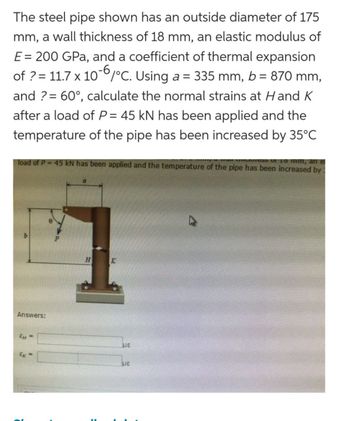
Structural Analysis
6th Edition
ISBN: 9781337630931
Author: KASSIMALI, Aslam.
Publisher: Cengage,
expand_more
expand_more
format_list_bulleted
Concept explainers
Question

Transcribed Image Text:The steel pipe shown has an outside diameter of 175
mm, a wall thickness of 18 mm, an elastic modulus of
E = 200 GPa, and a coefficient of thermal expansion
of ? = 11.7 x 10-6/°C. Using a = 335 mm, b = 870 mm,
and ?= 60°, calculate the normal strains at Hand K
after a load of P= 45 kN has been applied and the
temperature of the pipe has been increased by 35°C
O 16 mm, an e
load of P= 45 kN has been applied and the temperature of the pipe has been increased by
Answers:
EH =
Ek=
H
K
με
με
Expert Solution
This question has been solved!
Explore an expertly crafted, step-by-step solution for a thorough understanding of key concepts.
Step by stepSolved in 2 steps with 2 images

Knowledge Booster
Learn more about
Need a deep-dive on the concept behind this application? Look no further. Learn more about this topic, civil-engineering and related others by exploring similar questions and additional content below.Similar questions
- A student wants to measure the strain at a particular point K on a loaded specimen, so she affixes a 45° strain rosette at point K and obtains the following results: €A = 390 μrad EB = 275 μrad Ec = 325 prad After packing up and going home to analyse her results, she realises that the strain rosette was misaligned by 0 degrees CW (where a negative corresponds to CCW) from the x-y axes-ie. Gauge C is not parallel with the x-axis and is instead parallel with a different x' axis that is rotated by 0 degrees-where: 0 = 16 deg Instead of replacing the rosette and retaking measurements, the student realises she can use what she learned in ENGG2400 to find the strains she's interested in. b 45° 45° a) Draw a diagram of the situation, showing both the x-y axes and the strain rosette. b) Calculate Exx, Eyy and Yxy. c) Calculate the maximum in-plane shear strain and the associated average normal strain. I Xarrow_forwardProblems: Stress (ksi) 53.2 1. Determine the ductility (u) of the material based on the stress- strain diagram (problem S5.1). 43.6 37.1 0.0013 0.0063 0.163 0.247 Strain (in/in)arrow_forwardA brass alloy rod having a cross sectional area of 0.24 in.2and a modulus of 16 * 106 psi is subjected to a tensile load. Plastic deformation was observed to begin at a load of 8,944 lb.a. Determine the maximum stress that can be applied without plastic deformation.b. If the maximum length to which a specimen may be stretched without causing plastic deformation is 3.28 in., what is the original specimen length?arrow_forward
arrow_back_ios
arrow_forward_ios
Recommended textbooks for you

 Structural Analysis (10th Edition)Civil EngineeringISBN:9780134610672Author:Russell C. HibbelerPublisher:PEARSON
Structural Analysis (10th Edition)Civil EngineeringISBN:9780134610672Author:Russell C. HibbelerPublisher:PEARSON Principles of Foundation Engineering (MindTap Cou...Civil EngineeringISBN:9781337705028Author:Braja M. Das, Nagaratnam SivakuganPublisher:Cengage Learning
Principles of Foundation Engineering (MindTap Cou...Civil EngineeringISBN:9781337705028Author:Braja M. Das, Nagaratnam SivakuganPublisher:Cengage Learning Fundamentals of Structural AnalysisCivil EngineeringISBN:9780073398006Author:Kenneth M. Leet Emeritus, Chia-Ming Uang, Joel LanningPublisher:McGraw-Hill Education
Fundamentals of Structural AnalysisCivil EngineeringISBN:9780073398006Author:Kenneth M. Leet Emeritus, Chia-Ming Uang, Joel LanningPublisher:McGraw-Hill Education
 Traffic and Highway EngineeringCivil EngineeringISBN:9781305156241Author:Garber, Nicholas J.Publisher:Cengage Learning
Traffic and Highway EngineeringCivil EngineeringISBN:9781305156241Author:Garber, Nicholas J.Publisher:Cengage Learning


Structural Analysis (10th Edition)
Civil Engineering
ISBN:9780134610672
Author:Russell C. Hibbeler
Publisher:PEARSON

Principles of Foundation Engineering (MindTap Cou...
Civil Engineering
ISBN:9781337705028
Author:Braja M. Das, Nagaratnam Sivakugan
Publisher:Cengage Learning

Fundamentals of Structural Analysis
Civil Engineering
ISBN:9780073398006
Author:Kenneth M. Leet Emeritus, Chia-Ming Uang, Joel Lanning
Publisher:McGraw-Hill Education


Traffic and Highway Engineering
Civil Engineering
ISBN:9781305156241
Author:Garber, Nicholas J.
Publisher:Cengage Learning